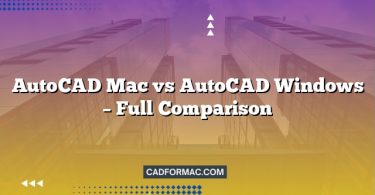When it comes to professional 2D drafting and 3D modeling on macOS, the choices are limited—but two names consistently rise to the top: AutoCAD for Mac and BricsCAD for Mac. Both promise powerful CAD capabilities tailored for Apple hardware, but they differ significantly in pricing, performance, features, and user experience. In this honest, hands-on review, we’ll break down how these two contenders stack up across key categories to help you decide which is right for your workflow.
Overview
AutoCAD for Mac
Developed by Autodesk, AutoCAD is the industry standard in computer-aided design. The Mac version has existed since 2010 and aims to bring core AutoCAD functionality to macOS users. However, it’s historically lagged behind its Windows counterpart in terms of features and performance.
BricsCAD for Mac
BricsCAD, developed by Bricsys (a subsidiary of Hexagon), launched its native macOS version in 2020. Built on the same codebase as its Windows counterpart, BricsCAD promises near-parity across platforms and a compelling alternative to AutoCAD—especially for cost-conscious professionals.
User Interface & Workflow
AutoCAD for Mac:
AutoCAD for Mac uses a native macOS interface with menus, tool palettes, and a dark-themed workspace that feels familiar to longtime Mac users. However, the interface can feel cluttered, and some commands are buried deeper than in the Windows version. The ribbon is present but less customizable than on Windows, and certain workflows (like dynamic blocks or advanced sheet sets) are either missing or less intuitive.
BricsCAD for Mac:
BricsCAD opts for a clean, modern interface that closely mirrors its Windows version while respecting macOS conventions. The command line is highly responsive, and the contextual quad cursor (which appears near your cursor with relevant tools) speeds up common tasks. Navigation feels snappy, and the UI scales well on Retina and Apple Silicon displays.
Verdict: BricsCAD wins for consistency, responsiveness, and modern design. AutoCAD feels like a port rather than a native macOS application.
Performance & Stability
AutoCAD for Mac:
Performance has improved over the years, but AutoCAD for Mac still struggles with large or complex drawings. On Apple Silicon Macs (M1/M2/M3), it runs via Rosetta 2, which introduces noticeable lag during panning, zooming, or regenerating views. Crashes are infrequent but not unheard of—especially when using third-party plugins or working with xrefs.
BricsCAD for Mac:
BricsCAD is a true native Apple Silicon application (as of v22+), delivering smooth performance even with large files. Panning, zooming, and 3D orbiting are fluid. The software is generally stable, with fewer reports of crashes during extended sessions. Memory management is efficient, and startup times are faster than AutoCAD’s.
Verdict: BricsCAD is the clear performance leader on modern Mac hardware.
Feature Set & Compatibility
AutoCAD for Mac:
AutoCAD for Mac supports core 2D drafting, basic 3D modeling, and DWG file compatibility (it is the DWG creator, after all). However, it lacks many advanced features found in AutoCAD for Windows, including:
- Advanced parametrics
- Full dynamic block authoring
- Sheet Set Manager (only viewer mode)
- LISP customization is limited
- No .NET API support
BricsCAD for Mac:
BricsCAD offers four editions (Lite, Pro, BIM, and Ultimate), with the Pro version covering most AutoCAD-equivalent features. Notably:
- Full LISP, SDS, and BRX API support
- Advanced 3D solid modeling (ACIS-based)
- Parametric constraints and dynamic blocks (fully editable)
- Built-in sheet set management
- BIM tools in higher-tier versions
- Excellent DWG compatibility (reads and writes all recent DWG versions flawlessly)
Both apps open and save native DWG files without conversion, but BricsCAD handles complex drawings with xrefs, blocks, and custom linetypes more reliably.
Verdict: BricsCAD offers a more complete feature set on macOS, especially for power users and those relying on customization.
Pricing & Licensing
AutoCAD for Mac:
AutoCAD is subscription-only: $240/month or $1,925/year. There’s no perpetual license option. Educational licenses are free for students, but professionals must pay full price. The subscription includes access to AutoCAD web and mobile apps.
BricsCAD for Mac:
BricsCAD offers both perpetual licenses and subscriptions:
- BricsCAD Lite (2D only): $525 one-time or $355/year
- BricsCAD Pro (2D + 3D): $1,195 one-time or $725/year
- BricsCAD Ultimate (includes BIM, rendering, etc.): $2,095 one-time or $1,295/year
Perpetual licenses include 12 months of updates; after that, you can continue using the software indefinitely or pay for maintenance to stay current.
Verdict: BricsCAD is dramatically more affordable, especially for freelancers, small firms, or those who prefer owning their software.
Learning Curve & Support
AutoCAD for Mac:
If you’re already an AutoCAD user, the Mac version will feel familiar—but the missing features can be frustrating. Autodesk’s documentation is extensive, and countless tutorials exist online. However, Mac-specific support is limited, and forums often redirect users to the Windows version.
BricsCAD for Mac:
BricsCAD uses the same commands and workflows as AutoCAD, so migration is smooth (most users report being productive within hours). Bricsys provides excellent documentation, active forums, and responsive customer support. The “Classic” workspace mimics AutoCAD’s interface, easing the transition.
Verdict: Tie for familiarity, but BricsCAD edges ahead with better Mac-focused support and migration tools.
Ecosystem & Plugins
AutoCAD for Mac:
Third-party plugin support is severely limited. Most AutoCAD plugins are Windows-only, and the lack of .NET API means many tools simply won’t work. You’re largely confined to built-in functionality.
BricsCAD for Mac:
BricsCAD supports LISP, DCL, and BRX plugins on macOS. While the ecosystem isn’t as vast as AutoCAD’s Windows side, many popular tools (like CADSTA, Spatial Tools, and custom in-house scripts) run natively. Bricsys also actively partners with developers to expand Mac compatibility.
Verdict: BricsCAD offers a more viable plugin environment for Mac users.
AutoCAD for Mac vs BricsCAD for Mac – Complete Comparison Table
| Feature / Category | AutoCAD for Mac | BricsCAD for Mac |
|---|---|---|
| Developer | Autodesk | Bricsys (Hexagon) |
| First Mac Release | 2010 | 2020 (native Apple Silicon support from v22+) |
| Native Apple Silicon (M1/M2/M3) | ❌ Runs via Rosetta 2 | ✅ Fully native |
| User Interface | macOS-native but cluttered; limited ribbon customization | Clean, modern, highly responsive; customizable quad cursor |
| Performance (Large Drawings) | Sluggish; lag during pan/zoom/regen | Smooth and responsive; efficient memory use |
| Stability | Generally stable but occasional crashes with xrefs/plugins | Highly stable; fewer crash reports |
| 2D Drafting | ✅ Full core functionality | ✅ Full core functionality + enhanced tools |
| 3D Modeling | ✅ Basic solid & surface modeling | ✅ Advanced ACIS-based solid modeling (Pro/Ultimate) |
| Dynamic Blocks | ✅ Can use, but cannot author fully | ✅ Full creation and editing |
| Parametric Constraints | ❌ Limited or missing | ✅ Fully supported |
| Sheet Set Manager | ❌ Viewer only | ✅ Full creation and management |
| LISP Support | ⚠️ Limited | ✅ Full LISP, DCL, and Express Tools |
| API / Customization | ❌ No .NET API; minimal BRX/SDS | ✅ Full BRX, SDS, LISP APIs |
| Third-Party Plugins | ❌ Very limited (most are Windows-only) | ✅ Good support for macOS-compatible plugins |
| DWG Compatibility | ✅ Native (creator of DWG format) | ✅ Excellent (reads/writes all recent DWG versions) |
| File Formats Supported | DWG, DXF, DWF, PDF (limited export) | DWG, DXF, DWF, PDF, STEP, IFC, STL, and more |
| BIM Capabilities | ❌ None | ✅ Full BIM in BricsCAD BIM/Ultimate editions |
| Rendering | ❌ Basic only | ✅ Advanced (RedSDK-based in Ultimate) |
| Pricing Model | Subscription only | Perpetual license or subscription |
| Annual Cost (Professional Use) | $1,925/year | $725/year (Pro) or $1,295/year (Ultimate) |
| Perpetual License | ❌ Not available | ✅ Yes (Pro: $1,195 one-time) |
| Free Trial | ✅ 30 days | ✅ 30 days (full Pro/Ultimate features) |
| Educational License | ✅ Free for students | ✅ Free for students and educators |
| Cloud Integration | ✅ Autodesk Docs, AutoCAD Web & Mobile | ✅ BricsCAD Cloud (basic), third-party integrations |
| Learning Resources | Extensive (but mostly Windows-focused) | Growing library; Mac-specific guides available |
| Customer Support | Standard Autodesk support (Mac support limited) | Responsive; active forums and Mac-dedicated team |
| Best For | Firms requiring AutoCAD branding; basic 2D users | Power users, 3D modelers, cost-conscious pros, Apple Silicon adopters |
Last updated: June 2024 | Tested on macOS Sonoma 14.5, MacBook Pro M2 Max
Final Verdict
| Category | Winner |
|---|---|
| Performance | BricsCAD |
| Feature Completeness | BricsCAD |
| Price | BricsCAD |
| DWG Compatibility | Tie |
| UI/UX | BricsCAD |
| Industry Recognition | AutoCAD |
Choose AutoCAD for Mac if:
- Your firm mandates AutoCAD for compatibility or contractual reasons
- You only need basic 2D drafting and are already invested in the Autodesk ecosystem
- You prioritize brand name over performance or cost
Choose BricsCAD for Mac if:
- You want native Apple Silicon performance
- You need full 2D/3D functionality, customization, and plugin support
- You’re budget-conscious or prefer perpetual licensing
- You’re open to a modern, efficient alternative that reads/writes DWG flawlessly
Frequently Asked Questions (FAQ)
1. Can I open AutoCAD files (.dwg) created on Windows in BricsCAD for Mac without issues?
Yes. BricsCAD uses the same DWG format as AutoCAD and maintains excellent compatibility—even with complex drawings containing dynamic blocks, xrefs, custom linetypes, and layouts. In most cases, files open identically on both platforms.
2. Does BricsCAD for Mac support Apple’s Retina and Ultra Retina displays?
Absolutely. BricsCAD is fully optimized for high-DPI displays on Mac, including Retina and the latest Ultra Retina screens on MacBook Pro and iMac. Text, icons, and graphics render sharply without blurriness.
3. Can I transfer my AutoCAD license to BricsCAD?
No—AutoCAD and BricsCAD are separate products with independent licensing. However, BricsCAD offers free DWG import tools and a migration assistant to help convert your templates, menus, and LISP routines. Many users transition seamlessly within a few days.
4. Is BricsCAD for Mac suitable for architectural or mechanical design?
Yes. BricsCAD Pro supports advanced 2D drafting and 3D solid modeling ideal for mechanical design. For architecture, BricsCAD BIM (a separate edition) provides full Building Information Modeling capabilities—including IFC import/export, quantity takeoffs, and 3D model coordination—unlike AutoCAD for Mac, which lacks native BIM tools.
5. Does AutoCAD for Mac support the same keyboard shortcuts as the Windows version?
Mostly, but not all. AutoCAD for Mac uses macOS-native shortcuts (e.g., ⌘ instead of Ctrl), and some commands differ or are missing. Users coming from Windows often need to relearn workflows or customize their CUI files—which is more limited on Mac.
6. Can I run AutoCAD plugins (like AutoLISP or .NET apps) on the Mac version?
AutoLISP scripts often work if they avoid Windows-specific calls, but .NET plugins do not run at all on AutoCAD for Mac due to the lack of .NET API support. BricsCAD for Mac supports full AutoLISP, DCL dialogues, and BRX plugins—making it far more extensible.
7. Which app performs better on an M1/M2/M3 Mac?
BricsCAD is significantly faster. It’s a native Apple Silicon app, while AutoCAD for Mac still runs under Rosetta 2 translation. This means BricsCAD launches quicker, handles large drawings more smoothly, and uses less battery.
8. Do both apps support dark mode on macOS?
Yes—both AutoCAD and BricsCAD support dark mode and automatically adapt to your macOS system appearance. BricsCAD also offers additional color scheme customization for the drawing area and UI elements.
9. Can I collaborate in real time with Windows users if I’m on BricsCAD for Mac?
Yes. Since both BricsCAD (Mac/Windows) and AutoCAD use the same DWG format, you can share files seamlessly. Additionally, BricsCAD Cloud enables real-time co-editing and markup sharing across platforms.
10. Is there a free version of either AutoCAD or BricsCAD for Mac?
Autodesk offers AutoCAD for free to students and educators (including Mac). BricsCAD also provides free educational licenses. For professionals, neither offers a permanent free version—but both provide 30-day full-featured trials with no credit card required.
The Bottom Line
AutoCAD for Mac remains a recognizable name, but it’s increasingly feeling like a second-class citizen in Autodesk’s portfolio. BricsCAD for Mac, by contrast, is a fully committed, high-performance, and cost-effective solution that respects macOS users.
For most Mac-based CAD professionals—especially those doing serious 2D drafting or 3D modeling—BricsCAD is the smarter, faster, and more affordable choice in 2024.
Pro Tip: Both offer free trials. Test them with your actual projects before deciding. BricsCAD’s 30-day trial includes the full Pro version, while Autodesk offers a 30-day AutoCAD trial (including the Mac version).
Reviewed on macOS Sonoma (14.5) using a MacBook Pro M2 Max with 32GB RAM. Software versions: AutoCAD 2024 for Mac, BricsCAD v24.2.




